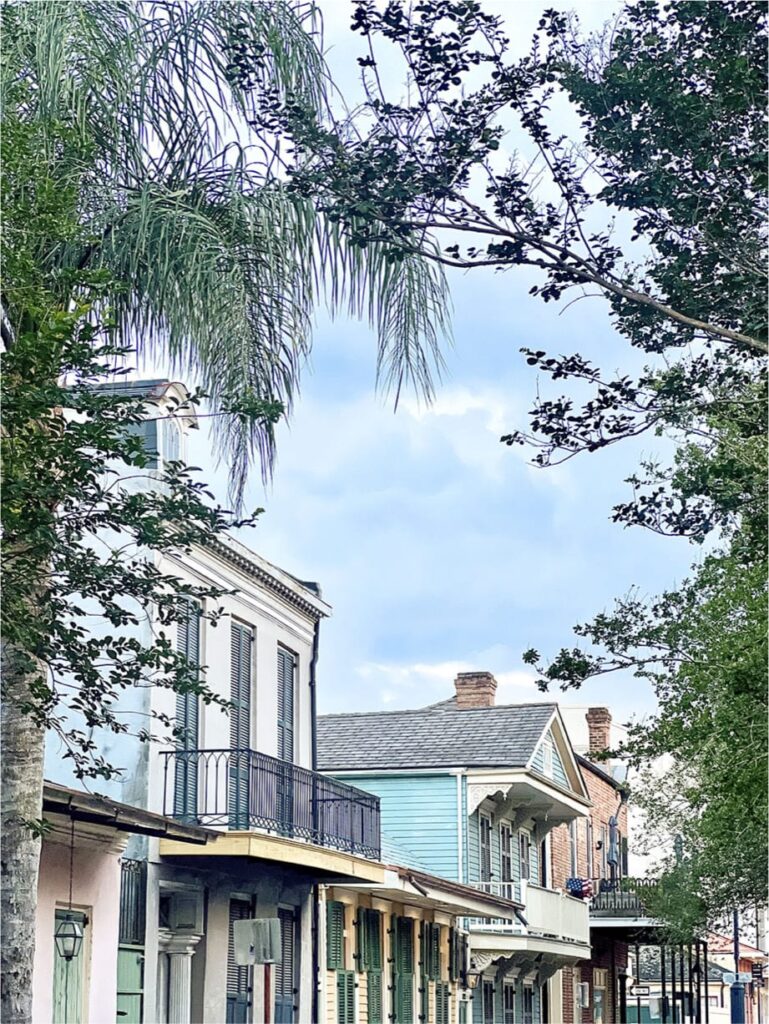Archives, databases, local institutions, and expert tips can help you uncover the history of your New Orleans home and piece together fascinating narratives that have shaped the unique character of our city.
Here are a few resources to help you research a building’s history:
The New Orleans Public Library
- The New Orleans Public Library has a list of resources for researching buildings, including information for verifying changes in numerical or street addresses. The New Orleans address system, for example, was reorganized in 1894, so being aware of changes in numbers and names can make researching newspaper archives and maps much more productive.
- If you have a Louisiana library card, you have access to the Louisiana Library Connection. This database houses digitized newspaper archives, maps, genealogy resources and more. When searching through newspapers, make sure to use quotation marks around the address. For example: “923 Tchoupitoulas” instead of 923 Tchoupitoulas. This will narrow your search to that specific address instead of every instance where 923 or Tchoupitoulas is mentioned throughout the newspaper’s history.
- Email archivist@nolalibrary.org to request a visit to the archives located at the main branch of the library to view plan books, maps, photographs and more. Learn more about the New Orleans Public Library’s collections here.
Sanborn Fire Insurance Maps
- In brief, these maps are documentation of existing buildings at a certain time. The maps contain details, such as location on a block, type of framing, building height by number of stories, and use.
- You can search these maps by date, volume, and sheet. Each volume has a key indicating what area that volume covers.
- If you have a Louisiana library card, you can access the Sanborn Fire Insurance Maps through the Louisiana Library Connection. Under databases, choose either Fire Insurance Maps Online or Sanborn Maps. (The two are slightly different in operation.)
- If you do not have a library card, you can access the maps through the Library of Congress.
State Historic Preservation Office
- The State Historic Preservation Office website has a GIS map of the state with cultural and national historic districts listed, links to structure surveys by FEMA and other sources, and National Register nomination packets.
French Quarter buildings
- A wealth of history and architectural descriptions for French Quarter buildings can be found at The Historic New Orleans Collection’s Vieux Carré Digital Survey. The digital survey “is an extensive study of the properties within the French Quarter referencing essential historical, architectural, legal and sociological data on individual lots and structures from the French colonial period to the present,” according to The Historic New Orleans Collection.
- The Vieux Carré Commission Foundation’s Vieux Carré Virtual Library includes an interactive map searchable by address and provides photographs and a color rating system that “indicates the historical and/or architectural significance of each property under the VCC’s jurisdiction,” according to the site.
Want to narrow down a construction date or building owner? If so, you may want to do a chain of title. A chain of title follows a lot of land from the present day back to its original subdivision, when a larger piece of land was subdivided into squares and lots. It is important to note that for many years, notarial records were kept in the personal offices of the notary publics in New Orleans. Therefore, some records are missing or damaged, resulting in a missing “link” in a chain. But that doesn’t necessarily mean you’ve reached the end of the road for your research project.
Start by looking at the City of New Orleans Property Viewer. Input an address and jot down a few key facts from the Property Information category, including the property description. The property description will provide the lot and square, referenced typically by letters or numbers, as well as the lot size, and a brief description of the building. If you scroll down on that page, you can see if the building is located in a local historic district.
From the New Orleans Property Viewer, click on the Assessor Records and Sales/Transfers link. It lists real estate transactions, typically back to the 1970s or ’80s, depending on when the property was bought and sold within the last 50 years. Write down a few of the transactions, making sure to include the Instrument and Notarial Archive Numbers where provided.
Next, bring your Notarial Archive/Instrument Numbers and Property Description to the Notarial Archives Office on the fourth floor of 1340 Poydras St. Once there, the helpful staff can assist you in developing your Chain of Title.
At the computers in the research area, pull up the conveyance site. (They are saved as shortcuts to the desktop, so you don’t have to search for it. Don’t be afraid to ask for help!) Fill out the date, name, address and Notarial Archive Number. Fill out as much information as possible, and it should pull up acts of sale for the property. Make sure to write down any pertinent information. In the summary of the sale, there will be “COB” and “FOL” followed by numbers.
COB stands for Conveyance Office Book. FOL stands for folio or page. This refers to the book and page number where you will complete your chain of title.
With your first COB and FOL in hand, walk back to area where the Conveyance Office Books are stored. For example: if your act of sale says COB 404, FOL 67, you will look for a book that says Conveyance Book 404, and you will turn to page 67. (Again, ask for help! There are lots of books.)
Once you have the right book and page number, find the act of sale that refers to your property; verify it is accurate via the owner’s name, date of sale, address, or lot number. The sale description will give you the previous owner and the COB/FOL from the act of sale when the previous owner purchased the property. Remember to write down all pertinent information (taking pictures is not allowed, but making copies is), including the notary for the sale and any changes to the lot lines or mailing address, before moving on to the next COB/FOL.

Leave the Research
to the PRC!
Need further assistance or want to leave the work to the experts? PRC’s History & Landmarks Plaque Program offers research services, ranging from a property’s chain of title to a full building history, which is then published in a hardcover commemorative book. Qualified properties also may request a bronze historic marker. Historic markers may highlight noteworthy people, events, places or facts associated with the property, as well as a description of the architectural style. Learn more about the History & Landmarks Plaque Program and see pricing.







